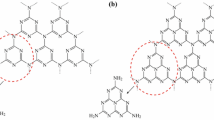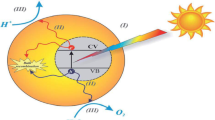Abstract
The photocatalytic performance of heterostructure photocatalysts is limited in practical use due to the charge accumulation at the interface and its low efficiency in utilizing solar energy during photocatalytic process. In this work, a ternary hierarchical TiO2 nanorod arrays/graphene/ZnO nanocomposite is prepared by using graphene sheets as bridge between TiO2 nanorod arrays (NRAs) and ZnO nanoparticles (NPs) via a facile combination of spin-coating and chemical vapor deposition techniques. The experimental study reveals that the graphene sheets provide a barrier-free access to transport photo-excited electrons from rutile TiO2 NRAs and ZnO NPs. In addition, there generates an interface scattering effect of visible light as the graphene sheets provide appreciable nucleation sites for ZnO NPs. This synergistic effect in the ternary nanocomposite gives rise to a largely enhanced photocurrent density and visible light-driven photocatalytic activity, which is 2.6 times higher than that of regular TiO2 NRAs/ZnO NPs heterostructure. It is expected that this hierarchical nanocomposite will be a promising candidate for applications in environmental remediation and energy fields.








Similar content being viewed by others
References
Fujishima A, Honda K (1972) Electrochemical photolysis of water at a semiconductor electrode. Nature 238:37–38
Su J, Guo L, Bao N, Grimes CA (2011) Nanostructured WO3/BiVO4 heterojunction films for efficient photoelectrochemical water splitting. Nano Lett 11:1928–1933
Jang ES, Won JH, Hwang SJ, Choy JH (2006) Fine tuning of the face orientation of ZnO crystals to optimize their photocatalytic activity. Adv Mater 18:3309–3312
Xiao X, Hu R, Liu C (2013) Facile large-scale synthesis of β-Bi2O3 nanospheres as a highly efficient photocatalyst for the degradation of acetaminophen under visible light irradiation. Appl Catal B 140:433–443
Cao S, Wang CJ, Lv XJ (2015) A highly efficient photocatalytic H2 evolution system using colloidal CdS nanorods and nickel nanoparticles in water under visible light irradiation. Appl Catal B 162:381–391
Ratanatawanate C, Xiong C, Balkus KJ Jr (2008) Fabrication of PbS quantum dot doped TiO2 nanotubes. ACS Nano 2:1682–1688
Ran J, Zhang J, Yu J, Jaroniec M, Qiao SZ (2014) Earth-abundant cocatalysts for semiconductor-based photocatalytic water splitting. Chem Soc Rev 43:7787–7812
Tran PD, Wong LH, Barber J, Loo JS (2012) Recent advances in hybrid photocatalysts for solar fuel production. Energy Environ Sci 5:5902–5918
Yu JG, Yu XX (2008) Hydrothermal synthesis and photocatalytic activity of zinc oxide hollow spheres. Environ Sci Technol 23:4902–4907
Lu F, Cai W, Zhang Y (2010) ZnO Hierarchical micro/nanoarchitectures: solvothermal synthesis and structurally enhanced photocatalytic performance. Adv Funct Mater 18:1047–1056
Girish Kumar S, Koteswara Rao KSR (2017) Comparison of modification strategies towards enhanced charge carrier separation and photocatalytic degradation activity of metal oxide semiconductors (TiO2, WO3 and ZnO). Appl Surf Sci 391:124–148
Sushma C, Girish Kumar S (2017) Advancements in the zinc oxide nanomaterials for efficient photocatalysis. Chem Pap 71:2023–2042
Mclaren A, Valdessolis T, Li G, Tsang SC (2009) Shape and size effects of ZnO nanocrystals on photocatalytic activity. J Am Chem Soc 131:12540–12541
Zhang Z, Shao C, Li X, Zhang L, Xue H, Wang C, Liu Y (2010) Electrospun nanofibers of ZnO–SnO2 heterojunction with high photocatalytic activity. J Phys Chem C 52:7920–7925
Moniz SJA, Zhu J, Tang J (2014) 1D Co-Pi modified BiVO4/ZnO junction cascade for efficient photoelectrochemical water cleavage. Adv Energy Mater 4:1066–1070
Han C, Chen Z, Zhang N, Colmenares JC, Xu YJ (2014) Hierarchically CdS decorated 1D ZnO nanorods-2D graphene hybrids: low temperature synthesis and enhanced photocatalytic performance. Adv Funct Mater 25:221–229
Siwińska-Stefańska K, Kubiaka A, Piasecki A, Goscianska J, Nowaczyk G, Jurga S, Jesionowski T (2018) TiO2–ZnO binary oxide systems: comprehensive characterization and tests of photocatalytic activity. Materials 11:841–859
Zhang X, Dong S, Zhou X, Yan L, Chen G (2015) A facile one-pot synthesis of Er–Al codoped ZnO nanoparticles with enhanced photocatalytic performance under visible light. Mater Lett 143:312–314
Li D, Huang JF, Cao LY, Jia LI, Ouyang HB (2014) Microwave hydrothermal synthesis of Sr2+ doped ZnO crystallites with enhanced photocatalytic properties. Ceram Int 40:2647–2653
Yu C, Yang K, Xie Y, Fan Q, Yu JC (2013) Novel hollow Pt–ZnO nanocomposite microspheres with hierarchical structure and enhanced photocatalytic activity and stability. Nanoscale 5:2142–2151
He W, Kim HK, Wamer WG, Melka D, Callahan JH (2014) Photogenerated charge carriers and reactive oxygen species in ZnO/Au hybrid nanostructures with enhanced photocatalytic and antibacterial activity. J Am Chem Soc 136:750–757
Girish Kumar S, Koteswara Rao KSR (2015) Zinc oxide based photocatalysis: tailoring surface bulk structure and related interfacial charge carrier dynamics for better environmental applications. RSC Adv 5:3306–3351
Pirhashemia M, Habibi-Yangjeha A, Pouran SR (2018) Review on the criteria anticipated for the fabrication of highly efficient ZnO-based visible-light-driven photocatalysts. J Ind Eng Chem 62:1–25
Ahmad M, Ahmed E, Hong ZL, Xu JF, Khalid NR (2013) A facile one-step approach to synthesizing ZnO/graphene composites for enhanced degradation of methylene blue under visible light. Appl Surf Sci 274:273–281
Chen Z, Zhang N, Xu YJ (2013) Synthesis of graphene–ZnO nanorod nanocomposites with improved photoactivity and anti-photocorrosion. CrystEngComm 15:3022–3030
Ge M, Cao C, Huang J, Li S, Chen Z (2016) A review of one-dimensional TiO2 nanostructured materials for environmental and energy applications. J Mater Chem A 4:6772–6801
Luo C, Ren X, Dai Z, Zhang Y, Qi X, Pan C (2017) Present perspectives of advanced characterization techniques in TiO2-based photocatalysts. Appl Mater Interfaces 9:23265–23286
Lei Y, Zhao G, Liu M, Zhang Z, Tong X (2009) Fabrication, characterization, and photo-electrocatalytic application of ZnO nanorods grafted on vertically aligned TiO2 nanotubes. J Phys Chem C 113:19067–19076
Xiao FX (2012) Construction of highly ordered ZnO–TiO2 nanotube arrays (ZnO/TNTs) heterostructure for photocatalytic application. Appl Mater Interfaces 4:7055–7063
Han C, Yang MQ, Weng B, Xu YJ (2014) Improving the photocatalytic activity and anti-photocorrosion of semiconductor ZnO by coupling with versatile carbon. Phys Chem Chem Phys 43:1616891–1616903
Zhang Y, Luo C, Li W, Pan C (2013) Strain induced chemical potential difference between monolayer graphene sheets. Nanoscale 5:2616–2619
Hummers WS, Offeman RE (1958) Preparation of graphitic oxide. J Am Chem Soc 80:1339
Safa S, Sarraf R, Azimirad R (2014) Investigation of reduced graphene oxide effects on ultra-violet detection of ZnO thin film. Phys E 57:155–160
Ge MZ, Li SH, Huang JY, Zhang KQ, Aldeyab S (2015) TiO2 nanotube arrays loaded with reduced graphene oxide films: facile hybridization and promising photocatalytic application. J Mater Chem A 3:3491–3499
Zhang WF, He YL, Zhang MS, Yin Z, Chen Q (2000) Raman scattering study on anatase TiO2 nanocrystals. J Phys D Appl Phys 33:912–917
Gao L, Ren W, Li F, Cheng HM (2008) Total color difference for rapid and accurate identification of graphene. ACS Nano 2:1625–1633
Cancado LG, Jorio A, Martins EH, Stavale F, Achete CA, Capaz RB (2011) Quantifying defects in graphene via raman spectroscopy at different excitation energies. Nano Lett 11:3190–3196
Feng W, Wang Y, Chen J, Wang L, Guo L (2016) Reduced graphene oxide decorated with in situ growing ZnO nanocrystals: facile synthesis and enhanced microwave absorption properties. Carbon 108:52–60
Zhang Y, Li D, Tan X, Zhang B, Ruan X (2013) High quality graphene sheets from graphene oxide by hot-pressing. Carbon 54:143–148
Wei XX, Chen M, Guo SQ, Guo F, Li XM (2014) Advanced visible-light-driven photocatalyst BiOBr–TiO2–graphene composite with graphene as a nano-filler. J Mater Chem A 2:4667–4675
Mu J, Shao C, Guo Z, Zhang Z, Zhang M, Zhang P, Chen B, Liu Y (2011) High photocatalytic activity of ZnO–carbon nanofiber heteroarchitectures. Appl Mater Interfaces 3:590–596
Luo C, Li D, Wu W, Pan C (2015) Preparation of 3D reticulated ZnO/CNF/NiO heteroarchitecture for high-performance photocatalysis. Appl Catal B 166:217–223
Moussa H, Girot E, Mozet K, Alem H, Medjahdi G (2016) ZnO rods/reduced graphene oxide composites prepared via a solvothermal reaction for efficient sunlight-driven photocatalysis. Appl Catal B 185:11–21
Kim CH, Kim BH, Yang KS (2012) TiO2 nanoparticles loaded on graphene/carbon composite nanofibers by electrospinning for increased photocatalysis. Carbon 50:2472–2481
Song P, Zhang X, Sun M, Cui X, Lin Y (2012) Graphene oxide modified TiO2 nanotube arrays: enhanced visible light photoelectrochemical properties. Nanoscale 4:1800–1804
Gu L, Wang J, Cheng H, Zhao Y, Liu L, Han X (2013) One-step preparation of graphene-supported anatase TiO2 with exposed 001 facets and mechanism of enhanced photocatalytic properties. Appl Mater Interfaces 5:3085–3093
Yang MQ, Xu YJ (2013) Basic principles for observing the photosensitizer role of graphene in the graphene–semiconductor composite photocatalyst from a case study on graphene–ZnO. J Phys Chem C 117:21724–21734
Lightcap IV, Kosel TH, Kamat PV (2010) Anchoring semiconductor and metal nanoparticles on a two-dimensional catalyst mat, storing and shuttling electrons with reduced graphene oxide. Nano Lett 10:577–583
Siwińska-Stefańska K, Fluder M, Tylus W, Jesionowski T (2018) Investigation of amino-grafted TiO2/reduced graphene oxide hybrids as a novel photocatalyst used for decomposition of selected organic dyes. J Environ Manag 212:395–404
Li H, Xia Z, Chen J, Lei L, Xing J (2015) Constructing ternary CdS/reduced graphene oxide/TiO2 nanotube arrays hybrids for enhanced visible-light-driven photoelectrochemical and photocatalytic activity. Appl Catal B 168:105–113
Khoa NT, Kim SW, Yoo DH, Cho S, Kim EJ (2015) Fabrication of Au/graphene-wrapped ZnO-nanoparticle-assembled hollow spheres with effective photoinduced charge transfer for photocatalysis. Appl Mater Interfaces 7:3524–3531
Zhang Y, Li X, Hua X, Ma N, Chen D, Wang H (2009) Sunlight photocatalysis in coral-like TiO2 film. Scr Mater 61:296–299
Wu J, Luo C, Li D, Fu Q, Pan C (2016) Preparation of Au nanoparticle-decorated ZnO/NiO heterostructure via nonsolvent method for high-performance photocatalysis. J Mater Sci 52:1–11
Acknowledgements
This work was supported by the Shenzhen Science and Technology Innovation Committee 2017 basic research (free exploration) project of Shenzhen City of China (No. JCYJ20170303170542173), the National Nature Science Foundation of China (No. 11174227) and Chinese Universities Scientific Fund.
Author information
Authors and Affiliations
Corresponding authors
Electronic supplementary material
Below is the link to the electronic supplementary material.
Rights and permissions
About this article
Cite this article
Wang, Z., Luo, C., Zhang, Y. et al. Construction of hierarchical TiO2 nanorod array/graphene/ZnO nanocomposites for high-performance photocatalysis. J Mater Sci 53, 15376–15389 (2018). https://doi.org/10.1007/s10853-018-2724-3
Received:
Accepted:
Published:
Issue Date:
DOI: https://doi.org/10.1007/s10853-018-2724-3




